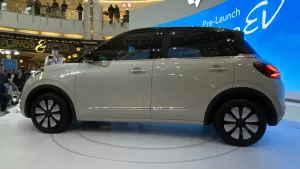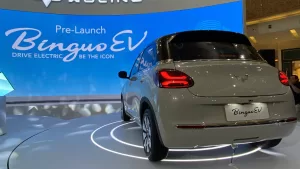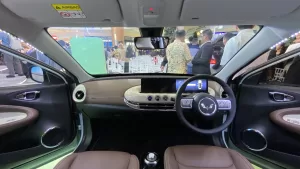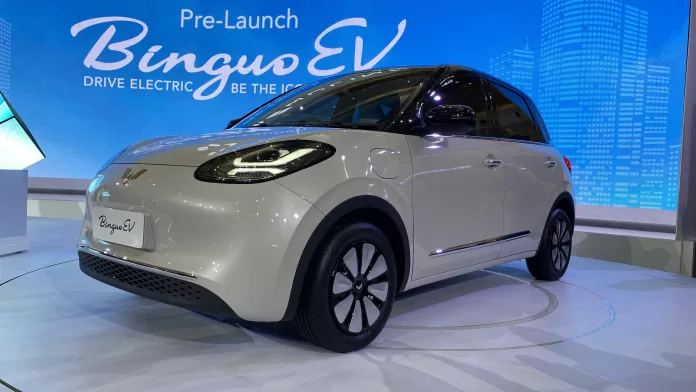Wuling Motors finally launched their second pure electric car, Wuling Binguo ev this week. This electric car further complements Wuling’s flagship Battery Electric Vehicle (BEV) lineup.
Previously, Wuling had also marketed a small electric car, the Wuling Air ev. The presence of the Wuling Binguo ev also makes the electric car market in Indonesia increasingly crowded.
The addition of new ammunition will certainly make the electric car market grow. Is it true?
What is certain is that Wuling Binguo ev has many advantages that Wuling Air ev does not have. In terms of dimensions, the Wuling Air ev is 2,974 mm long, 1,505 mm wide and 1,631 mm high, and has a wheelbase of 2,010 mm. This makes it quite compact and comfortable to use on fairly narrow urban streets.
Meanwhile, the Wuling BinguoEV offers a more spacious cabin. This can be seen from the length of 3,950 mm, width 1,708 mm and height 1,580 mm. Meanwhile, the wheelbase is 2,560 mm.
These two electric car models also use rims of different sizes. The Air EV uses 12 inch rims with tires measuring 145/70. Meanwhile, the BinguoEV is equipped with 15 inch alloy wheels wrapped in 185/60 tires.
Entering the inside, the BinguoEV interior will remind us of the Air EV cabin, only wrapped in a more elegant concept. The same impression can be felt from the transmission knob, which both uses a Rotary Gear Selector.

Unfortunately, the Wuling BinguoEV is not equipped with Wuling Indonesia Command voice commands like the Air ev. This is an excellent feature where the car can be controlled just by voice commands such as opening/closing the windows.
BinguoEV is also supported by an Intelligent Tech Dashboard on the front which combines futuristic panels and knobs as well as a wide interface screen. On the dashboard, there is a Multifunction Steering Wheel with a silver Wuling logo which is equipped with audio and menu operation buttons.
On the Intelligent Tech Dashboard, Wuling presents a touch of sophistication through the Integrated Floating Wide Screen. This area consists of a head unit with dimensions of 10.25 inches and a meter cluster which also measures 10.25 inches.
Regarding safety and security, the Wuling BinguoEV is equipped with dual front airbags, ABS and EBD, Electric Parking Brake with Automatic Vehicle Hold, Rear Parking Sensor and Camera, ISOFIX, Tire Pressure Monitoring System, and Immobilizer.
Regarding performance, the Wuling Air ev is offered in two mileage variants, namely 200 km for the Standard Range and Lite types, and 300 km for the Long Range type. Meanwhile, the BinguoEV offers a range of 333 km with a 31.9 kWh battery, and 410 km with a 37.9 kWh battery.
This means that the market segmentation of Wuling Air EV and Binguo EV is different. So it is very natural that Dian Asmahani, Brand and Marketing Director of Wuling Motors, said that the presence of the Binguo EV electric car will not “eat up” the Wuling Air ev market.

“Actually, Air EV is a different market segment. If we talk about the shape of the product itself, it’s different,” said Dian Asmahani.
Dian further confirmed that the Wuling Binguo ev has a hatchback shape and larger dimensions than the Wuling Air ev. Wuling Binguo EV is considered more suitable for the family car market.
“(Wuling Binguo ev) might be more suitable for families and operations if for several companies and for long-term travel,” said Dian.
“Actually, because the Air EV is compact, it is suitable for narrow, congested Indonesian roads, that is also suitable for the Air EV and this could be an urban mobility solution,” he continued.
Unfortunately, Wuling Motors is still keeping information on the price of their new electric car tightly closed. What is certain is that there are many rumors circulating that the Wuling Binguo EV was forced to appear in response to the presence of another Chinese electric car, namely the Neta V.
Currently Neta V is being sold for IDR 378 million. It’s possible that the Wuling Binguo ev is in the same price range.

Meanwhile, Grant Thornton Indonesia CEO Johanna Gani said that the development of electric cars in Indonesia continues to grow, especially after the government provided many incentives to this industry. However, it is not easy to develop this industry in the future because it faces a number of challenges.
“There are still many obstacles and challenges to developing the electric vehicle industry in Indonesia, such as battery technology processing which requires sophisticated technology and quite large costs, as well as limited battery infrastructure for electric vehicles,” he said.
So even though new electric car models arrive without supporting elements, people still think twice about buying an electric car.





